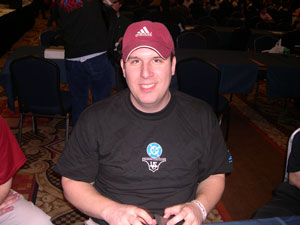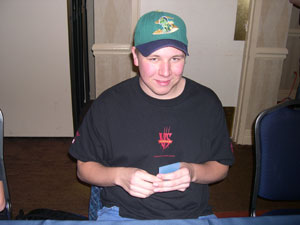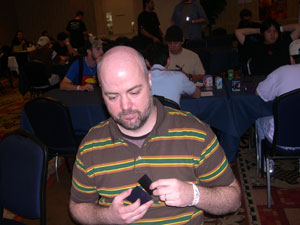
The Marvel Modern Age PCQ season is upon us, and if the results of Pro Circuit Atlanta and the recent $10K in Austin are any indication, we can look forward to an exciting, diverse, and mercurial metagame. In the following article, I’ll try to give you an introduction to the decks you need to be prepared for, but more importantly, we’ll also look at how those decks might be modified to help you get to San Francisco.
As the explosion of X-Faces at Austin demonstrates, the metagame can and will change from one tournament to the next as players try to gain an advantage over their less adaptable competitors. What was tech at Atlanta was old news by Austin; you wouldn’t bring a spoon to a knife fight, would you?
Weeks later, Austin is still the defining event for the current MMA metagame, so it makes sense to start our discussion with the deck that Doug Tice used to take home his third $10K trophy.
Doug Tice, $10K Austin, First Place
Characters
1 Ape X
4 Archangel, Angel
1 Beetle ◊ Mach 1
4 Beetle, Armorsmith
3 Cannonball, Blast Field
2 Dallas Riordan, Mayoral Aide
1 Gargantua
1 Joystick
1 Marcus Daniels ◊ Blackout
1 Melissa Gold ◊ Screaming Mimi
2 Melissa Gold ◊ Songbird, Sonic Carapace
1 Melter
1 Nathan Garrett
1 Ogre
1 Paul Ebersol ◊ Fixer
1 Plant Man
1 Shocker, Vibro-Shock Villain
1 Speed Demon, Second Chance Speedster
1 Viper
4 Yellowjacket
1 Radioactive Man, Chen Lu
Plot Twists
1 Brave New World
4 Faces of Evil
4 Hard Sound Construct
4 Mob Mentality
3 Mystic Summons
3 Null Time Zone
1 Stormfront-1
1 X-Men United
Locations
4 X-Corp: Amsterdam
Equipment
1 Blackbird Blue
At Pro Circuit Atlanta, twenty players showed up with X-Faces, and an astounding seventy-five percent of them made Day 2. Fast forward to Austin, a tournament one quarter the size of the PC, and we have the same number of players running Beetle, Armorsmith; Faces of Evil; and Archangel, Angel. X-Faces’ shift from seven percent to twenty-five percent of the overall metagame shows how fast a metagame can change from one tournament to another. Players know a good idea when they see one, and the flexibility, resilience, and offensive power offered by X-Faces seems to have left a lasting impression.
 It’s ironic that the most metagame-changing deck is perhaps the least open to tuning. Tice’s list is extremely tight; there just isn’t room for any other plot twists. You could cut Null Time Zone for more ATK pump, but the growing popularity of cards like System Failure makes that seem greedy. There are utility characters that would be a natural fit for the deck—Roy Harper ◊ Speedy and Fatality, Emerald Assassin spring to mind—but using most of them would lead to a quick dismissal from Vs. System Organized Play. Doug Tice and fellow Top 8 finisher Neil Reeves played identical copies of X-Faces, and it’s hard to imagine any way to improve or modify the deck for the upcoming PCQ season.
It’s ironic that the most metagame-changing deck is perhaps the least open to tuning. Tice’s list is extremely tight; there just isn’t room for any other plot twists. You could cut Null Time Zone for more ATK pump, but the growing popularity of cards like System Failure makes that seem greedy. There are utility characters that would be a natural fit for the deck—Roy Harper ◊ Speedy and Fatality, Emerald Assassin spring to mind—but using most of them would lead to a quick dismissal from Vs. System Organized Play. Doug Tice and fellow Top 8 finisher Neil Reeves played identical copies of X-Faces, and it’s hard to imagine any way to improve or modify the deck for the upcoming PCQ season.
This, of course, doesn’t mean that other decks can’t be tuned to beat or do better against Austin’s most-played deck. The next deck we’ll be looking at is Squadron Supreme. You can take Squadron in a lot of different ways, as evidenced by the Top 8 at Austin.
Kyle Dembinski, $10K Austin, Second Place
Characters
4 Joystick
4 Ape X
1 Quagmire
4 Shape
4 Melissa Gold ◊ Songbird, Sonic Carapace
1 Tom Thumb
4 Lady Lark, Linda Lewis
1 Lady Lark, Skylark
4 Golden Archer
4 Albert Gaines ◊ Nuke
1 Whizzer
Plot Twists
4 Answer the Call
4 Panacea Potion
4 Flying Kick
3 Other-Earth
2 Windstorm
Locations
2 Rocket Central
Equipment
4 Thunder Jet
3 Image Inducer
2 Airskimmer
 Dembinski’s list is the most focused of the Squadron lists in the Top 8. It eschews the Enemy of My Enemy–enabled “silver bullets” like Hawkeye, Clinton Barton; Speed Demon, Second Chance Speedster; and Firestar, Hellion that were in the builds piloted by Eric Ramirez and Robert Rau.
Dembinski’s list is the most focused of the Squadron lists in the Top 8. It eschews the Enemy of My Enemy–enabled “silver bullets” like Hawkeye, Clinton Barton; Speed Demon, Second Chance Speedster; and Firestar, Hellion that were in the builds piloted by Eric Ramirez and Robert Rau.
One thing to note is that there is only one swarm-punishing Hawkeye, Clinton Barton in the whole Top 8. X-Faces’ use of Mob Mentality and Brave New World means that in the matchup that Hawkeye was made for, he ends up being an awful 4-drop with a useless ability and a small butt. When people stop playing Hawkeye, the Mob Mentality / Brave New World combo no longer becomes a “must have” for swarm decks. Squadron, for instance, wants to go off-curve for all sorts of reasons. The 1- and 2-drops it runs are huge and playing multiple guys in a turn helps the Squad player empty his or her hand even faster. I’m not saying you should cut Golden Archer or Albert Gaines ◊ Nuke from your Squadron list, but there’s something to be said for playing enough 1- and 2-drops to consistently play two guys on turn 3. Dembinski’s eight 1-drops seem like too few; somewhere between ten and twelve is probably optimal. Being able to keep up with X-Faces’ swarm of small characters allows the Squadron player not only to maximize damage, but also to keep the opponent’s character count manageable.
With X-Faces’ growing popularity, one Whizzer and at least three Other-Earths become mandatory for any Squadron build. Whizzer’s ability to attack twice shines against weenie decks, where the chances of his stunning are near zero. Combine the 5-drop Speedster with an Other-Earth, and you’ve got a quick loss of 20 endurance points for the X-Faces player. If Dembinski had drawn Other-Earth in either of his games against Doug Tice in the finals of $10K Austin, the tournament probably would have ended with a different player holding up the trophy. In much the same way that Mob Mentality / Brave New World punishes players for using Hawkeye, Other-Earth punishes X-Faces for wasting resource points recruiting and activating Marcus Daniels ◊ Blackout.
X-Faces has also led to a resurgence in the popularity of System Failure. Going into PC Atlanta, Failure was pretty much useless against the two most popular decks (Squadron and Brotherhood / Avengers reservist). System Failure, however, is fantastic against X-Faces, and it has started to see more play because of that. It’s still almost useless against Squadron, a deck whose characters have, for the most part, extraordinarily high printed ATK values. The one creature it’s going to be good against in Squadron is Ape X. With more people packing System Failure, it makes sense to decrease the number of Ape Xs in favor of other aggressive 1-drops like Electric Eve and Angel Dust—guys that cannot be System Failured even with a Thunder Jet.
If you decide to run Enemy of My Enemy, I suggest running one copy of Sabretooth, Savage Killer. With him in your deck, the Hellfire Club matchup goes from slightly uphill to an absolute joke. He also helps against the Mental control decks—nothing quite like cracking a Sage, Tessa on turn 5 for 14. Just watch out for the Other-Earth–trumping Mind Control.
In his Austin coverage, Anand Khare noted that some of the very few X-Faces players from Pro Circuit Atlanta switched to Hellfire Club and Mental control decks for the Texas $10K. While obviously different, both decks basically want to do the same thing: slow the game down and beat the aggro-decks on a turn they never want to see, usually 7 or 8. Hellfire Club and Mental control decks might even be called metagame decks insofar as they seem to be designed specifically to combat the offensively minded, late-game–lacking strategies that dominate the MMA format.
David Spears, $10K Austin, Top 8
Characters
1 Donald Pierce
1 Magneto, Black Lord
4 Sage, Tessa
3 Shinobi Shaw
4 Mastermind, Dark Dreamer
4 Madelyne Pryor
4 Empath
4 Courtney Ross
1 Sebastian Shaw
2 Hellfire Club Initiate
4 Tarot
Plot Twists
4 Power and Wealth
3 Mutant Massacre
4 Join the Club!
4 Army of One
1 Power Play
2 System Failure
1 Absolute Power
1 Flying Kick
Locations
4 Shaw Industries
3 The Hellfire Club
2 Massachusetts Academy
 I like Dave Spears’s Hellfire Club list more than the one that was piloted by his fellow Top 8 competitor William Page. Spears’s character core is very focused and tries to exploit the Mental leanings of Sage, Tessa and Tarot fully. Mutant Massacre is superior to Raising Hell insofar as it can allow you to cripple X-Faces by locking it out of key characters like Beetle, Armorsmith or Yellowjacket. Both players are running two copies of the aforementioned System Failure to help combat the X-menace. Shrink seems like a perfect fit for the deck; Page runs four, but Spears runs zero. While X-Faces has a lot of offensive firepower, its main ATK pump, Faces of Evil, is not at all versatile. It only has four copies of Mob Mentality with which to respond to a DEF pump or a power-up. In combination with Shaw Industries and Army of One, Shrink makes it much more likely for the X-Faces player, or even for the overly aggressive Squadron player, to fail a crucial attack. In any case, Shrink forces your opponent to use more ATK pumps, making it easier for you to punish him or her with System Failure.
I like Dave Spears’s Hellfire Club list more than the one that was piloted by his fellow Top 8 competitor William Page. Spears’s character core is very focused and tries to exploit the Mental leanings of Sage, Tessa and Tarot fully. Mutant Massacre is superior to Raising Hell insofar as it can allow you to cripple X-Faces by locking it out of key characters like Beetle, Armorsmith or Yellowjacket. Both players are running two copies of the aforementioned System Failure to help combat the X-menace. Shrink seems like a perfect fit for the deck; Page runs four, but Spears runs zero. While X-Faces has a lot of offensive firepower, its main ATK pump, Faces of Evil, is not at all versatile. It only has four copies of Mob Mentality with which to respond to a DEF pump or a power-up. In combination with Shaw Industries and Army of One, Shrink makes it much more likely for the X-Faces player, or even for the overly aggressive Squadron player, to fail a crucial attack. In any case, Shrink forces your opponent to use more ATK pumps, making it easier for you to punish him or her with System Failure.
One other card that could find a home in Hellfire Club lists is Momentary Distraction. The Physical requirement is extremely limiting, especially in a deck dominated by Mental characters. But in combination with Shinobi Shaw, the deck’s de facto 5-drop, you can often brick-wall the unsuspecting opponent on turn 5. X-Faces may name System Failure with Null Time Zone, and they may even name Army of One, but they will rarely name (or play around) Momentary Distraction.
Tim Batow, $10K Austin, Top 8
Characters
4 Artie
2 Destiny, Freedom Force
4 Sage, Tessa
2 The Beautiful Dreamer
4 Tarot
4 Professor X, Headmaster
4 Emma Frost, Friend or Foe
4 Jean Grey, Red
2 Exodus
1 Rachel Summers ◊ Phoenix
1 Magneto, Ruler of Avalon
Plot Twists
4 Eye of the Storm
4 Duck and Cover
4 Enemy of My Enemy
4 Mutopia
3 X-Treme Maneuver
3 System Failure
3 Phoenix Rising
2 Mind Control
Locations
1 X-Corp: Amsterdam
Batow’s Mental control deck is even more reliant on Sage, Tessa than Spears’s or Page’s Hellfire Club builds. I haven’t played a ton of games with the deck, but I can’t imagine winning without hitting the concealed 2-drop. That being said, if you hit Sage, the Mental control deck becomes an extremely powerful answer to both X-Faces and Squadron. Most of what I’ve said about Hellfire Club applies equally to the above deck. Again, Shrink seems like a natural fit for such a defensively minded deck, insofar as it gives you, for all intents and purposes, a second set of Duck and Covers. System Failure shines in this deck more than any other, and I would strongly consider playing four after seeing how popular X-Faces was in Austin. Although Harry Leland is a Physical character, his ability to turn every Mental card in your hand into a Duck and Cover / Burn Rubber seems very attractive in the aggressive MMA metagame.
X-Faces was the most played deck at $10K Austin, but it still represented only twenty-five percent of the field. In fact, there were more people in Texas playing rogue decks than there were people playing with Blackbird Blue. By all means, tune your deck to beat X-Faces, Squadron, Hellfire Club, or if you’re Einstein, all three, but don’t forget that at the PCQ level, nothing is certain. Don’t be surprised if you play against two Avengers decks piloted by players who didn’t get the memo that Wonder Man isn’t good anymore. Whatever deck you decide to play in the PCQ this weekend, expect the unexpected, and if you can, prepare for it.